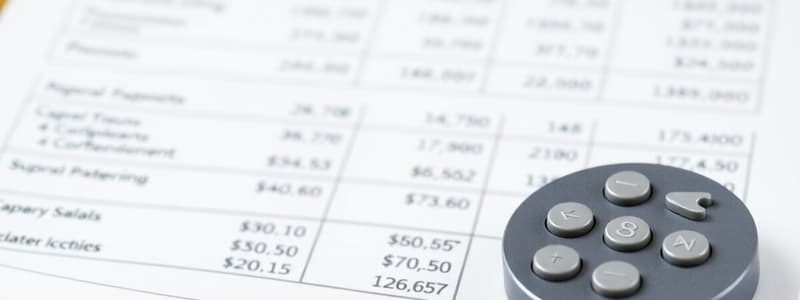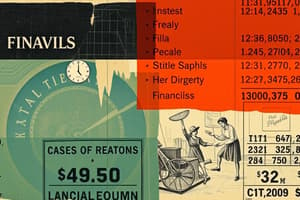Podcast
Questions and Answers
What does the income statement primarily report?
What does the income statement primarily report?
- Cash flow from investments and financing
- Total assets and liabilities of the business
- Revenue and expenses to determine profit or loss (correct)
- Changes in stockholder equity
Which of the following accounts would be classified as an asset?
Which of the following accounts would be classified as an asset?
- Notes Payable
- Accumulated Depreciation
- Building (correct)
- Accounts Payable
In financial accounting, what does 'Accounts Receivable' refer to?
In financial accounting, what does 'Accounts Receivable' refer to?
- Cash available for immediate use
- Amounts owed to the business by customers (correct)
- Estimates of collectible debts
- Amounts the business owes to its suppliers
What is the purpose of the Allowance for Bad Debts account?
What is the purpose of the Allowance for Bad Debts account?
Which account would be classified under liabilities?
Which account would be classified under liabilities?
What is the primary purpose of an account in accounting?
What is the primary purpose of an account in accounting?
How is equity calculated in financial statements?
How is equity calculated in financial statements?
Which of the following best defines revenue?
Which of the following best defines revenue?
What is the distinction between expenses and losses?
What is the distinction between expenses and losses?
Which of these is NOT considered a financial statement element?
Which of these is NOT considered a financial statement element?
Flashcards are hidden until you start studying
Study Notes
Accounts
- Accounts are the basic building blocks of accounting, storing information about increases and decreases in specific items.
- They are visualized as T-accounts with three parts: account title, debit side, and credit side.
Financial Statement Elements
- Assets are resources controlled by a company that provide future economic benefits.
- Liabilities are present obligations of a company that require the company to give up resources in the future.
- Equity represents the owners' stake in the company, calculated as total assets minus total liabilities.
- Income represents increases in economic benefits during a period, excluding owner investments.
- Expenses represent decreases in economic benefits during a period, excluding distributions to owners.
Income
- Income is comprised of both revenue and gains.
- Revenue is income generated from ordinary business activities.
- Gains are income from activities or transactions not part of regular business operations.
Expenses
- Expenses consist of both expenses and losses.
- Expenses are decreases in economic benefits from ordinary business activities.
- Losses are decreases in economic benefits from non-ordinary business activities.
Balance Sheet Accounts
- The balance sheet categorizes assets, liabilities, and equity.
- Assets are resources owned by a business.
- Liabilities are amounts owed by a business.
- Equity is the owners’ stake in a company, calculated as assets minus liabilities.
Income Statement Accounts
- The income statement categorizes income and expenses.
- Income is comprised of revenue and gains.
- Expenses are comprised of expenses and losses.
Common Account Titles and Descriptions
Assets
- Cash: Money readily available.
- Accounts Receivable: Amounts owed to the business by customers, supported by oral or informal promises to pay.
- Allowance for Bad Debts: Estimated losses from uncollectible accounts receivable.
- Notes Receivable: Amounts owed, supported by written or formal promises to pay.
- Inventory: Goods held for sale, or in process of production for a manufacturing business.
- Prepaid Supplies: Cost of unused office and other supplies.
- Prepaid Rent: Rent paid in advance.
- Prepaid Insurance: Cost of insurance paid in advance.
- Land: Plot of land used for the business building.
- Building: The structure used by the business.
- Equipment: Machinery, transportation equipment, office equipment, computer equipment, and furniture.
Liabilities
- Accounts Payable: Obligations supported by oral or informal promises to pay.
- Notes Payable: Obligations supported by written or formal promises to pay.
Equity
- Owner's Drawings/Withdrawals: Temporary withdrawals by the owner from the business equity.
- Owner's Capital: Represents the residual amount of owner equity after deducting liabilities from assets.
Owner's Capital Account
- Increased by: Investment/Contribution by the owner and income/profit earned by the business.
- Decreased by: Withdrawals/Distributions to the owner and expenses/loss incurred by the business.
Other Notable Accounts
- Interest Payable: Interest that has been incurred but not yet paid.
- Salaries Payable: Salaries earned by employees but not yet paid.
- Utilities Payable: Unpaid utilities.
- Unearned Income: Income received in advance for services or goods not yet provided.
Expense Categories
- Utilities Expense: Represents the cost of utilities used during the accounting period.
- Supplies Expense: Represents the cost of supplies used during the accounting period.
- Bad Debt Expense: Represents estimated losses from uncollectible accounts receivable.
- Depreciation Expense: The portion of depreciable asset cost allocated to the current accounting period.
- Advertising Expense: Represents costs of promotional and marketing activities.
- Insurance Expense: Represents insurance costs pertaining to the current accounting period.
- Taxes and Licenses: Represents business and local taxes required by the government.
- Miscellaneous Expense: Represents various small expenditures.
- Transportation Expense: Represents the cost of transporting employees to and from work.
- Travel Expense: Represents costs incurred during business trips.
- Interest Expense: Represents the cost of borrowing money.
- Losses Expenses: Losses may or may not arise from normal business activities, including the sale of assets at a price below their carrying amount and decreases in asset value due to destruction, damage, or obsolescence.
The Relevance of Major Accounts
Income
- Income is the primary source of funds for a business.
- It covers expenses, invests in growth, and creates profits.
- It is crucial for maintaining financial health and funding future opportunities.
Equity
- Equity represents ownership value in a business.
- It is an indicator of financial health.
- It helps assess the net worth of an entity.
- It provides a buffer against losses.
Expenses
- Expenses support daily operations and the production of goods or services.
- Understanding and managing expenses is vital for profitability and financial management.
Liabilities
- Liabilities are financial obligations that need to be settled.
- They impact cash flow and financial stability.
- They are important for financing operations and growth.
- They must be managed carefully to avoid over-leverage.
Assets
- Assets are critical for generating revenue and supporting business operations.
- They provide the means to produce goods or services.
- They allow for investment in future opportunities and securing loans.
Studying That Suits You
Use AI to generate personalized quizzes and flashcards to suit your learning preferences.




